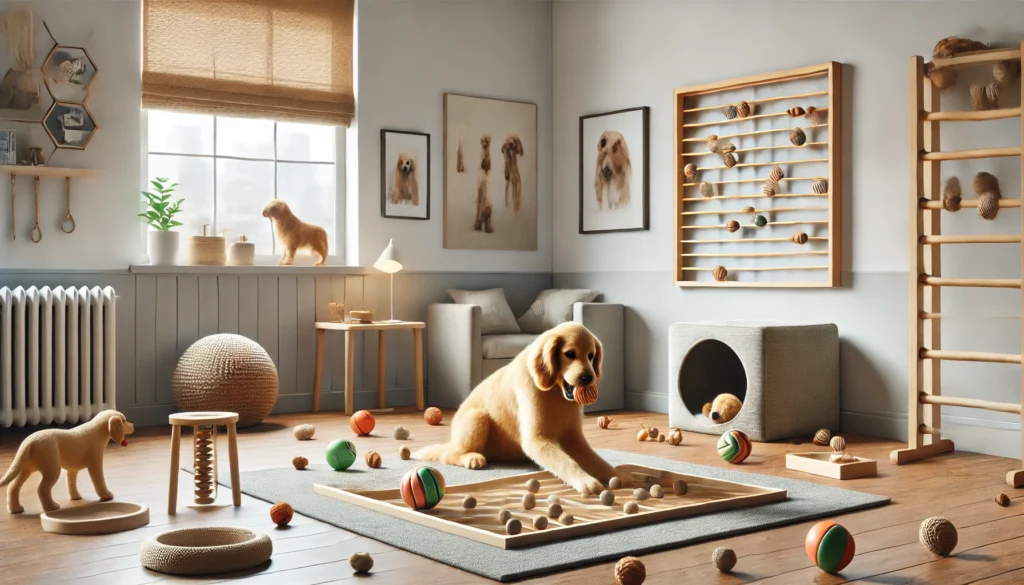Boredom is one of the most overlooked causes of behavioral issues in dogs — especially those that spend most of their time indoors. Dogs are social, intelligent animals who need more than food and shelter to thrive. Without proper mental and physical engagement, even the calmest pup can develop anxiety, excessive barking, chewing, or general restlessness.
The good news is that boredom can be prevented with simple daily habits that don’t require a huge yard, expensive gear, or all-day availability. In this guide, you’ll learn how to create a routine that keeps your indoor dog stimulated, happy, and well-balanced.
Why Dogs Get Bored Indoors
Life inside four walls limits your dog’s access to natural stimuli:
- No opportunity to sniff, chase, or explore
- Lack of interaction with other animals or people
- Predictable environment with few surprises
- Minimal exercise or challenges if walks are skipped
When dogs don’t have an outlet for their physical and mental energy, it builds up — and often gets released in less-than-ideal ways.
Signs Your Dog Is Bored
Common behavioral signs include:
- Chewing furniture or personal items
- Digging at carpets or doors
- Barking at nothing
- Whining or pacing
- Excessive licking or tail chasing
- Sleeping too much during the day
These behaviors aren’t “bad” — they’re symptoms of unmet needs.
Build a Boredom-Busting Daily Routine
Creating structure doesn’t mean complicating your life. A balanced day for your dog should include:
1. Morning Activity (10–20 minutes)
Start the day with light movement and engagement.
Options:
- Tug-of-war or indoor fetch
- Short sniff walk outside
- Puzzle feeder breakfast
- Scent game or “find it” training session
This sets the tone and releases overnight energy.
2. Solo Enrichment During Work Hours
When you’re busy or working from home, your dog still needs stimulation.
Ideas:
- Frozen Kong filled with peanut butter, yogurt, or kibble
- Snuffle mat with scattered food
- Treat-dispensing toys
- Lick mats for calming behavior
- Chew toys (bully sticks, rubber chews)
Rotate toys weekly to avoid boredom.
3. Midday Break (5–10 minutes)
Even a short reset makes a difference.
Try:
- Potty break + simple command review (sit, stay, down)
- Interactive play with a toy
- Training a new trick (“spin,” “touch,” “crawl”)
- Calming massage or brushing
This relieves stress and adds variety to their day.
4. Afternoon Rest and Reset
Encourage quiet time by:
- Lowering lights or playing soft music
- Offering a cozy nap space
- Avoiding overstimulation (TV, noisy toys)
Mental rest is as important as activity.
5. Evening Engagement (15–30 minutes)
Make up for missed walks or long work hours.
Options:
- Indoor agility (tunnels, jumps, steps)
- Obedience games (recall, “wait,” “leave it”)
- Trick progression (“roll over,” “shake,” “target”)
- Group toy play or flirt pole session
Finish with a calming chew and water.
Weekly Extras for Variety
Mix in special activities to keep things fresh:
- Teach a new cue or name-based toy game
- Rearrange furniture to create new routes
- Schedule a training session with new challenges
- Offer a DIY scavenger hunt around the house
- Play “which hand has the treat?” scent games
Novelty boosts mental sharpness and strengthens your bond.
Mental Games That Tire the Brain
Mental workouts are just as tiring as physical ones — and often more effective indoors.
Top choices:
- Hide-and-seek (you or a toy)
- Shell game with cups and treats
- Shaping games using a clicker or marker
- DIY cardboard puzzles (hide treats in tubes or boxes)
Reward calm focus and stop before your dog loses interest.
Adjust Based on Breed and Energy Level
Every dog has different needs. Adapt intensity based on:
- High-energy breeds: need structured sessions and novelty
- Senior dogs: benefit from scent games and gentle interaction
- Working breeds: love problem-solving and purpose
- Shy dogs: respond best to calm, low-stimulus training
Pay attention to what works — and what doesn’t. You’ll learn your dog’s language of stimulation.
Manage the Environment
Make your space more engaging by:
- Offering window views or access to new smells
- Playing pet-safe music or dog TV in moderation
- Rotating resting zones (sunspot in the morning, crate in the afternoon)
- Creating obstacle paths with cushions, boxes, or stairs
Small changes can make a big difference.






